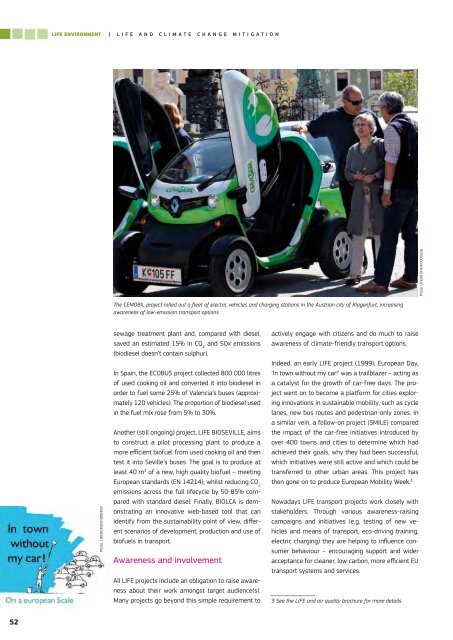You also want an ePaper? Increase the reach of your titles
YUMPU automatically turns print PDFs into web optimized ePapers that Google loves.
LIFE ENVIRONMENT |LIFE and Climate CHANGE mitigationPhoto: LIFE09 ENV/AT/000226The CEMOBIL project rolled out a fleet of electric vehicles and charging stations in the Austrian city of Klagenfurt, increasingawareness of low-emission transport optionsPhoto: LIFE99 ENV/F/000459sewage treatment plant and, compared with diesel,saved an estimated 15% in CO 2and SOx emissions(biodiesel doesn’t contain sulphur).In Spain, the ECOBUS project collected 800 000 litresof used cooking oil and converted it into biodiesel inorder to fuel some 25% of Valencia’s buses (approximately120 vehicles). The proportion of biodiesel usedin the fuel mix rose from 5% to 30%.Another (still ongoing) project, LIFE BIOSEVILLE, aimsto construct a pilot processing plant to produce amore efficient biofuel from used cooking oil and thentest it into Seville’s buses. The goal is to produce atleast 40 m 3 of a new, high quality biofuel – meetingEuropean standards (EN 14214); whilst reducing CO 2emissions across the full lifecycle by 50-85% comparedwith standard diesel. Finally, BIOLCA is demonstratingan innovative web-based tool that canidentify from the sustainability point of view, differentscenarios of development, production and use ofbiofuels in transport.Awareness and involvementAll LIFE projects include an obligation to raise awarenessabout their work amongst target audience(s).Many projects go beyond this simple requirement toactively engage with citizens and do much to raiseawareness of climate-friendly transport options.Indeed, an early LIFE project (1999), European Day,‘In town without my car!’ was a trailblazer – acting asa catalyst for the growth of car-free days. The projectwent on to become a platform for cities exploringinnovations in sustainable mobility, such as cyclelanes, new bus routes and pedestrian-only zones. Ina similar vein, a follow-on project (SMILE) comparedthe impact of the car-free initiatives introduced byover 400 towns and cities to determine which hadachieved their goals, why they had been successful,which initiatives were still active and which could betransferred to other urban areas. This project hasthen gone on to produce European Mobility Week. 3Nowadays LIFE transport projects work closely withstakeholders. Through various awareness-raisingcampaigns and initiatives (e.g. testing of new vehiclesand means of transport, eco-driving training,electric charging) they are helping to influence consumerbehaviour – encouraging support and wideracceptance for cleaner, low carbon, more efficient EUtransport systems and services.3 See the LIFE and air quality brochure for more details52


